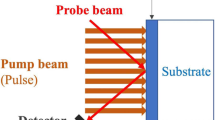Abstract
The converging thermal wave, flash technique for measuring thermal diffusivity is suitable for use on samples that are sufficiently thick or thin in comparison to the annular heat source, to be described by a three-dimensional or two-dimensional approximation of the heat conduction equation, and sufficiently absorbing to ensure generation of a heat source at the surface. However, samples of intermediate thickness, which lie between these regimes, cannot be analyzed. In this article, heat diffusion in the samples of varying thicknesses is modeled, and a semi-analytic expression is used to describe the dimensionality of any thickness, allowing the converging wave method to be extended to intermediate thickness samples. Applying the analysis to anisotropic samples, a method is proposed to find the anisotropy ratio of the in-plane to perpendicular-to-plane diffusivity using the converging wave method.
Similar content being viewed by others
Abbreviations
- A :
-
Ratio of sample thickness to detection distance
- I 0 :
-
Modified Bessel function of order zero
- l :
-
Sample thickness
- N :
-
Number of spatial dimensions
- p :
-
Dimensional parameter
- Q :
-
Heat source strength
- r :
-
Distance from center of the heat source
- R :
-
Radius of the heat source
- t :
-
Time
- t max :
-
Time at which thermal signal reaches maximum
- T :
-
Temperature
- α :
-
Thermal diffusivity
- α r :
-
Thermal diffusivity parallel to the surface
- α z :
-
Thermal diffusivity perpendicular to the surface
- ν :
-
Coefficient of heat loss
- τ max :
-
The minimum value of t max
References
Cielo P., Utracki L.A., Lamontagne M.: Can. J. Phys. 64, 1172 (1986)
H.S. Carslaw, J.C. Jaeger, Conduction of Heat in Solids, 2nd ed., ch. 10 (Oxford University Press, Oxford, 1959), p. 258
Murphy F., Kehoe T., Pietralla M., Winfield R., Floyd L.: Int. J. Heat Mass Transfer 48, 1395 (2005)
Lu G., Swann W.T.: Appl. Phys. Lett. 59, 1556 (1991)
Chae H.B., Park H., Hong J.S., Han Y.J., Joo Y., Baik Y.J., Lee J.K., Lee S.W.: Int. J. Thermophys. 22, 645 (2000)
Kim J.C., Kim D.J., Kim D.S., Kim S.W., Troitsky O.Yu.: Int. J. Thermophys. 22, 933 (2001)
Enguehard F., Boscher D., Deom A., Balageas D.: Mater. Sci. Eng. B5, 127 (1990)
Lide, D.R. (eds): CRC Handbook of Chemistry and Physics. CRC Press, Boca Raton, FL (1994)
Parker W.J., Jenkins R.J., Butler C.P., Abbott G.L.: J. Appl. Phys. 32, 1679 (1961)
Author information
Authors and Affiliations
Corresponding author
Rights and permissions
About this article
Cite this article
Kehoe, T., Murphy, F. & Kelly, P.V. A Method for Measuring the Thermal Diffusivity of Intermediate Thickness Surface Absorbing Samples and Obtaining the Ratio of Anisotropy by the Converging Wave Flash Method. Int J Thermophys 30, 987–1000 (2009). https://doi.org/10.1007/s10765-009-0574-6
Received:
Accepted:
Published:
Issue Date:
DOI: https://doi.org/10.1007/s10765-009-0574-6




